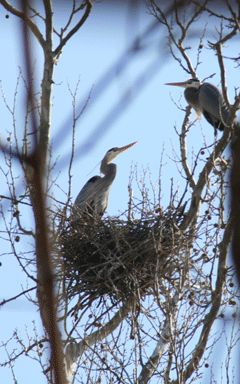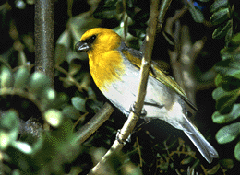Birds in Freefall
Air Date: Week of March 20, 2009

Great Blue Herons crowd the treetops on tiny Conn Island in the Potomac, not far from Washington, D.C. Herons are among the wetland species doing well—a bright spot among a sea of bad news about bird populations.
A new large-scale report finds roughly a quarter of all American bird species, in a variety of habitats, are in decline. But there are a few bright spots that point to potential for a turnaround. Living on Earth’s Jeff Young went visit Conn Island in the Potomac River and has our story.
Transcript
[SOUND OF RED COCKADE WOODPECKER]
GELLERMAN: The Red Cockaded Woodpecker – is a year-round resident of mature southern pine forests in the U.S.
But now it’s listed as endangered.
[SOUND OF RED COCKADED WOODPECKER]
GELLERMAN: A new report on America’s birds indicates many populations are in free
fall - over the last 40 years there have been dramatic declines in native species living in grassland, ocean and desert habitats. But not all is grim - as Living on Earth’s Jeff Young learned recently when he went birding not far from the nation’s capital.
[SOUND OF WALKING THROUGH BRUSH]
YOUNG: Conn Island is a couple hundred muddy acres in the middle of the Potomac River. In summer it’s covered with stinging nettles. And it frequently floods. But some consider Conn Island prime real estate.
MEHLMAN: It’s good news I spotted an adult bald eagle.
YOUNG: That’s Nature Conservancy bird expert David Mehlman who’s just caught our national bird in his binoculars. Mehlman recalls when that would have been a rarity. The bald eagle spent 40 years on the list of threatened and endangered species.

The endangered Palila of Hawaii¹s high mountains. Hawaii is home to one-third of all the birds on the U.S. list of endangered and threatened species. (Courtesy of the US Fish and Wildlife Service)
MEHLMAN: When I was a teenager eagles were very rare around here, in fact didn’t nest in Washington, DC area at all. But thanks to environmental improvement banning DDT and special legislation actually that protected eagles we’ve seen an enormous increase in eagles around the whole wider Chesapeake Bay area.
[SOUND OF WOODS]
YOUNG: It’s the kind of positive news Mehlman’s eager to accentuate, even when so much of the news in the State of the Birds report he helped to write is so gloomy. Federal and state agencies teamed with five conservation groups to dig into 40 years of data from breeding bird and waterfowl surveys and the Christmas bird counts. They used new statistical methods to find trends among birds according to habitat. Of the roughly 800 bird species in the country about 200 are in trouble.
Wetlands species provide one of the few bright spots. And Conn Island is proof. It’s not just the eagles. The island’s also an important nesting site for great blue herons. Mary Travaglini manages habitat restoration here for The Nature Conservancy.
TRAVAGLINI: Well two years ago when we were out here we counted 184 nests. The fact that we have so many herons here and they’re still here is rather interesting and I don’t know if that has to do with the fact that this island floods and that regenerates the soils. But a lot of heron rookeries actually essentially kill their own habitats with their droppings. The droppings are so intense and essentially toxic to the soil that they’ll end up killing the trees that their nests are in.
YOUNG: Boy they’re just like us: they want a quiet spot with a lot of food to raise their young and then they end up spoiling it with their own waste.
TRAVAGLINI: That’s right. Good point [laughs].

Great Blue Herons crowd the treetops on tiny Conn Island in the Potomac, not far from Washington, D.C. Herons are among the wetland species doing well—a bright spot among a sea of bad news about bird populations.
MEHLMAN: Let’s say each nest is like four birds, let’s do some math, that’s over 700 birds in a small area over months that’s a lot of bird droppings.
YOUNG: Alright I’m getting out my cap [laughter].
Now properly attired we venture forth.
So I’m just underneath the colony of the herons. They’re nesting way up high in the tops of sycamore trees.
[CROAKING SOUNDS]
YOUNG: Look at that it’s a heron condo up there!
MEHLMAN: I’d have to say close to 50 nests easily visible right from this point and we’re starting to hear some of the croaks and growls of the herons.
[CROAKING SOUNDS]
YOUNG: The scientists are constantly vigilant against any threats to the heron habitat. Travaglini pulls up a cluster of green from the sandy soil.
TRAVAGLINI: It’s called Star of Bethlehem it’s an exotic garden plant that’s invasive around here so I tend to grab it when I see it. [laughs].
YOUNG: So what’s the role of exotic invasives and bird populations?
MEHLMAN: Exotics or invasive species are one of the top threats to biodiversity of all kinds worldwide including birds. Non-native plants come in and can totally alter habitat type so it’s unsuitable for use by birds and other wildlife.
[SOUND OF WALKING THROUGH BRUSH]
YOUNG: The report shows invasive species, habitat loss and fragmentation, pesticides and disease all taking a tremendous toll on birds.
Arid land species like the Gunnison sage grouse fell 30 percent; grassland species like the northern bobwhite 40 percent due to sprawling development and agriculture.
Ocean species dropped almost 40 percent perhaps an indictor of much deeper problems with ocean food supplies. And despite recent gains in western and northern forests, the country’s eastern forest songbirds dropped by a quarter.
.gif)
Nature Conservancy bird expert David Mehlman on the lookout for coots,cormorants, eagles and herons that abound on this stretch of the Potomac:
"If we can do for other bird habitats what we've done for wetlands then I think there's reason for optimism."
WALLACE: Right now Hawaii has the dubious distinction of having had more avian extinctions since 1500 than any other place on earth.
YOUNG: Hawaii’s uniquely adapted species face an additional threat: avian malaria, which could expand higher into Hawaii’s mountains with climate change.
Of all the US birds on the threatened and endangered species list, Wallace says one third are in Hawaii. Yet only about four percent of government funding for recovery goes there.
WALLACE: We have species like the Palila with a population of only about 2,000 birds. We have species like the Maui parrot bill with a population of only about 500 individuals. These are some of the most endangered birds, indeed, not just in the US but on the planet and I think it’s important for this country to take action to prevent future extinctions.
YOUNG: The American Bird Conservancy also wants the Obama administration to reverse some Bush-era decisions on old growth logging in the Pacific Northwest to better protect the northern spotted owl and marbled murrelet.
The recommendations from the State of the Birds report are much broader than that. The authors encourage more public involvement in birding and more public and private money for conservation.
[SOUNDS OF WALKING THROUGH BRUSH]
YOUNG: And back on Conn island in the Potomac, David Mehlman has another recommendation: Don’t lose hope.
MEHLMAN: We do see signs that a change is possible. And these are wonderful testimonials to the success of what we can do if we put our minds and our dollars and our work to conservation. And we’re looking right here at two examples of that: the bald eagle and great blue heron. Couldn’t ask for better examples.
YOUNG: Mehlman and his colleagues found two bald eagle nests and 187 blue heron nests just here on tiny Conn Island. More reasons for optimism to take wing.
For Living on Earth I’m Jeff Young on the Potomac River in Maryland.
Links
More on the stretch of the Potomac River Jeff visited, and conservation efforts there
Living on Earth wants to hear from you!
Living on Earth
62 Calef Highway, Suite 212
Lee, NH 03861
Telephone: 617-287-4121
E-mail: comments@loe.org
Newsletter [Click here]
Donate to Living on Earth!
Living on Earth is an independent media program and relies entirely on contributions from listeners and institutions supporting public service. Please donate now to preserve an independent environmental voice.
NewsletterLiving on Earth offers a weekly delivery of the show's rundown to your mailbox. Sign up for our newsletter today!
 Sailors For The Sea: Be the change you want to sea.
Sailors For The Sea: Be the change you want to sea.
 The Grantham Foundation for the Protection of the Environment: Committed to protecting and improving the health of the global environment.
The Grantham Foundation for the Protection of the Environment: Committed to protecting and improving the health of the global environment.
 Contribute to Living on Earth and receive, as our gift to you, an archival print of one of Mark Seth Lender's extraordinary wildlife photographs. Follow the link to see Mark's current collection of photographs.
Contribute to Living on Earth and receive, as our gift to you, an archival print of one of Mark Seth Lender's extraordinary wildlife photographs. Follow the link to see Mark's current collection of photographs.
 Buy a signed copy of Mark Seth Lender's book Smeagull the Seagull & support Living on Earth
Buy a signed copy of Mark Seth Lender's book Smeagull the Seagull & support Living on Earth

